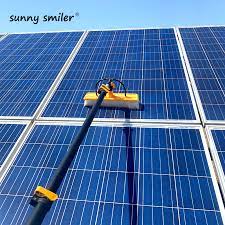10 Tips for Choosing the Right Solar Panel Cleaning Robot
10 Tips for Choosing the Right Solar Panel Cleaning Robot
Introduction: As the demand for renewable energy continues to grow, solar power has become an increasingly popular choice for individuals and businesses alike. To ensure optimal performance and efficiency of solar panels, regular cleaning is essential. With the advancements in technology, solar panel cleaning robots have emerged as an effective solution for maintaining clean and productive solar arrays. However, choosing the right cleaning robot can be a daunting task. In this article, we present ten essential tips to help you select the most suitable solar panel cleaning robot for your specific needs.
Efficiency and Cleaning Performance:
Consider the efficiency and cleaning performance of the robot. Look for a robot that utilizes advanced cleaning mechanisms, such as rotating brushes, high-pressure water jets, or microfiber cloths. The robot should effectively remove dirt, dust, bird droppings, and other debris from the solar panels without causing any damage.
Safety Features:
Ensure that the cleaning robot is equipped with safety features to protect both the robot and the solar panels. Look for features like obstacle detection sensors, anti-collision technology, and automatic shutdown in case of emergencies. These features will prevent damage to the panels and reduce the risk of accidents during the cleaning process.
Customizability and Adaptability:
Choose a cleaning robot that can be customized to meet the specific requirements of your solar panels. Consider the ability to adjust the cleaning schedule, cleaning patterns, and pressure settings to optimize the cleaning process for your particular installation. Additionally, ensure that the robot can adapt to different panel sizes, shapes, and orientations for maximum efficiency.
Power Source and Energy Efficiency:
Evaluate the power source and energy efficiency of the cleaning robot. Some robots are powered by solar energy, while others require external power sources. Solar-powered robots offer the advantage of sustainability and cost savings. Look for energy-efficient models that minimize power consumption without compromising cleaning performance.
Remote Monitoring and Control:
Consider a cleaning robot that offers remote monitoring and control capabilities. This feature allows you to track the cleaning progress, monitor performance, and make necessary adjustments from a centralized location. Remote control functionality enables you to operate the robot manually if required.
Durability and Weather Resistance:
Solar panel cleaning robots are exposed to various weather conditions. Choose a robot that is built with durable and weather-resistant materials to withstand harsh environments. Look for features like waterproofing, corrosion resistance, and UV protection to ensure longevity and reliability.
Ease of Maintenance:
Assess the ease of maintenance for the cleaning robot. Look for robots with easily replaceable parts and accessible maintenance points. Regular maintenance, such as cleaning or replacing brushes, should be straightforward and user-friendly.
Compatibility with Monitoring Systems:
Consider the compatibility of the cleaning robot with existing solar panel monitoring systems. Integration with your monitoring system can provide valuable data on the performance of the panels, cleaning schedules, and potential issues. Ensure that the robot can seamlessly communicate with your monitoring system to optimize overall solar array efficiency.
Manufacturer Reputation and Support:
Research the reputation and track record of the robot manufacturer. Read customer reviews, seek recommendations, and evaluate the manufacturer’s after-sales support and warranty policies. A reliable manufacturer with a good reputation ensures that you will receive prompt assistance and support when needed.
Cost and Return on Investment (ROI):
Evaluate the cost of the cleaning robot and its potential return on investment. Consider factors such as cleaning efficiency, energy savings, labor reduction, and increased solar panel output. Although the initial investment might be higher, a high-quality robot that delivers long-term benefits and cost savings can be a wise investment.
Conclusion:
Selecting the right solar panel cleaning robot is crucial to maintain the efficiency and longevity of your solar array. By considering factors such as cleaning performance, safety features, adaptability, power source, remote control capabilities, durability, compatibility, manufacturer reputation, and cost, you can make an informed decision. Investing in a reliable and efficient cleaning robot will ensure that your solar panels operate at their peak performance, resulting in increased energy production and a greener future.
